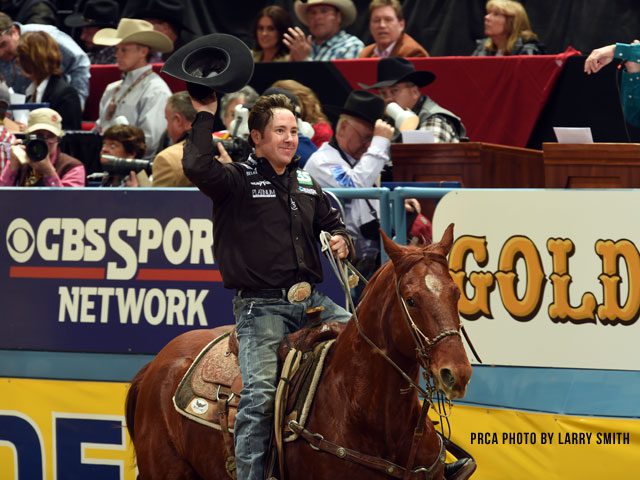Trevor Brazile’s name is missing from the top of the tie-down roping and all-around world standings.
The 23-time world champ has won more money than any other tie-down roper this year, and just came off a win at the National Western Stock Show and Rodeo in Denver last weekend. But as long as the lawsuit between the Elite Rodeo Association and the Pro Rodeo Cowboys Association continues, his name will be absent from the standings.
Brazile, who is on the board of directors for the ERA, and the other 79 ERA members, are allowed to compete in PRCA rodeos, but their names are not included in the world standings.
The ERA brought the anti-trust class action lawsuit against the PRCA in November of last year, after the PRCA passed bylaws in September stipulating that PRCA members could not compete in “conflicting rodeo associations while receiving the benefits of PRCA memberships.” Those conflicting rodeo associations were defined to be any associations that “produce, promote and/or sanction professional rodeo contests” in two or more rodeo events.
On Jan. 5, a federal judge ordered that all members of the lawsuit (ERA members) can compete in PRCA-sanctioned events until Feb. 12, giving them a chance to make a living while the suit is pending. Brazile has won about $18,000 since the new year, but that money was put in escrow by the PRCA until the suit is resolved. If the ERA would lose the lawsuit, the cowboys’ entry fees would be refunded but they would not receive the prize money they had won.
Brazile thinks the ERA brings great opportunities to the pro rodeo world. “This (association) was brought on to be a bonus to contestants, to have another opportunity for television, for endorsements to grow. It is a $4.6 million tour that wasn’t already in the industry, 52 hours of TV (coverage) that wasn’t already in the industry. I think it’s got a lot of positives.”
The ERA has announced its 2016 schedule, with fifteen rodeos in eight cities and a finals in Dallas in November. FOX Sports is set to broadcast the rodeos.
When the judge made the order, she also required the ERA and PRCA to attend mediation. The mediation was not successful, said world champion bareback rider and ERA contestant Bobby Mote. The ERA was never meant to replace the PRCA, he said, but enhance what already exists. “These (cowboys) need more chances to be able to make a living doing what they do. The fans want to have the opportunity to see the type of action they’ve grown accustomed to seeing (on television, during the broadcast of the Wrangler National Finals Rodeo). One time a year, you get to see all the (rodeo) stars in one place on TV, and the rest of the year, it’s up in the air if you get to see the top names in the sport.”
Rodeo could use more publicity, Mote said, and he believes the ERA’s television contract was a way to attain that. “Everybody agrees that we have a great sport, and it’s undersold, and the people who do it are undersold. There are so many stories in rodeo, but unless you’re really wired into the western industry and you know where to find them, you have no idea.”
Rodeo needs to be in front of more fans, he said. “How do you get in front of not only core rodeo fans, but other groups of fans, so that the sport can grow instead of stagnate or lose ground? These are all things we feel where the ERA can add exposure and can present it differently than it’s been presented in the past.”
The two associations could co-exist, Brazile believes. “It’s been said, a rising tide raises all ships. I hope (the ERA) has an effect on high school, college, and junior rodeos, and that more people want to be cowboys because of more opportunity, not because of restricting opportunities.”
Mote likens the position of the ERA cowboys and cowgirls to the Turtles –the early cowboys in the 1930s who “stuck their necks out” to form the Turtles Cowboy Association, the beginnings of the PRCA. “We’re the ones sticking our necks out and getting criticized, but at the same time, somebody’s got to do it. In my twenty years of rodeo, I haven’t seen enough positive change, to make me feel like the sport’s better off than when I started.”
The ERA has been compared to the Pro Bull Riders, which began in 1992 with a band of twenty bull riders who decided to form their own association. “I’ve talked to a lot of those (bull riders),” Mote said, “and they all tell me they faced a lot of the same obstacles and a lot of people criticized them. But you look around now and it’s hard to find somebody to criticize the PBR. Rodeo has benefited from the PBR, whether they want to admit it or not. It’s helped grow the industry and we hope this does the same.”
“I know I’m fighting for cowboys and cowgirls,” Brazile said, “for the industry itself, not just one group.”
When asked, the PRCA’s comment was such: “The PRCA has and will continue to vigorously defend this action and is confident in its position. As there are current motions pending before the court, the PRCA will not comment on specific matters, but can say that it will doggedly prosecute this action to a final dismissal or judgment of the court.”
Reprinted with permission from TriState Livestock News









